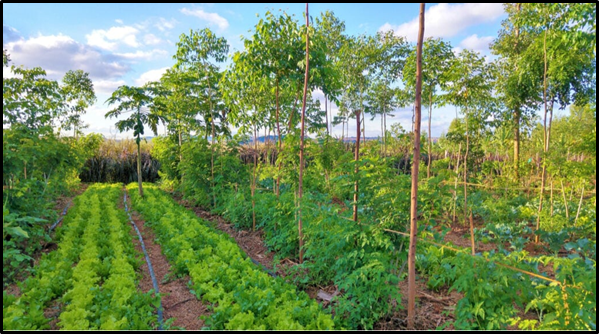GROW Report | NITI Aayog
@shutterstock
News
- Ramesh Chand, Member of NITI Aayog, introduced the Greening and Restoration of Wasteland with Agroforestry (GROW) report and portal on 12 January, 2024 at NITI Aayog.
About the Report
- This multi-institutional project, spearheaded by NITI Aayog, evaluated the viability of agroforestry in every Indian district using remote sensing and geographic information systems;
- An Agroforestry Suitability Index (ASI) was created for national-level prioritization using thematic datasets;
- The report offers district- and state-level analysis to assist government agencies and businesses with their greening and restoration initiatives.
Contents in the GROW Report
- Approximately 28.42 million hectares, or 8.65% of India’s total land area, are currently covered by agroforestry and the benefits of converting wastelands and other underutilized areas to agroforestry are highlighted in the current report;
- The GROW initiative, which aims to restore 26 million hectares of degraded land by 2030 and create an additional carbon sink of 2.5 to 3 billion tonnes of carbon dioxide equivalent, is in line with national commitments;
- The Union Budget of the Government of India (FY-2022-23) has prioritized the promotion of agroforestry and private forestry due to the importance of the goods and services that agroforestry provides;
- Rising build-up areas, degraded land, and unequal resource distribution are among the problems faced by India, the seventh-largest country in the world;
- In India, wasteland makes up about 16.96% of the Total Geographic Area and needs to be transformed for productive use. These wastelands are mapped and given a priority list for agroforestry interventions using geospatial technologies and Geographic information System (GIS);
- India, which introduced the National Agroforestry Policy in 2014, seeks to use this agroecological land use system to increase productivity, profitability, and sustainability;
- Agroforestry addresses issues with food, nutrition, energy, employment, and the environment by integrating trees, crops, and livestock;
- This is in line with international agreements such as the Green India Mission, the Paris Agreement, the Bonn Challenge, the UN Sustainable Development Goals, the United Nations Convention on Combating Desertification (UNCCD), and more.
Various Important Terms
- Wasteland: Land that is not utilized for agriculture, commerce, or forestry is referred to as wasteland, not desertified land. For example, it might utilize grasslands that local people use for grazing.
- Agroecology:
- About: Globally, agroecology is acknowledged as a system that improves fertile landscapes, boosts yields, brings back biodiversity and soil health, fosters climate resilience, and raises farmers’ standard of living. It is the examination of ecological processes as they relate to systems of agricultural production;
- Importance of Agroforestry: They are for effective nutrient cycling, organic matter addition for sustainable agriculture, and improved vegetation cover is highlighted by several significant policy initiatives, such as the National Forest Policy 1988, the National Agriculture Policy 2000, the Planning Commission Task Force on Greening India 2001, the National Bamboo Mission 2002, the National Policy on Farmers, 2007, and the Green India Mission 2010.
- National Agroforestry Policy, 2014:
- About:
- In February 2014, the Cabinet approved a policy that addresses issues the agroforestry sector faces, such as unfavorable policies, fragile markets, and a lack of institutional financing;
- India became the first country to implement a comprehensive agroforestry policy.
- Basic Objectives:
- Promote and grow tree planting in harmony and harmony with livestock and crops to enhance rural households’ productivity, jobs, income, and standard of living, especially for small-holder farmers;
- In order to reduce the risk during extreme weather events, protect and stabilize ecosystems and encourage resilient cropping and farming systems;
- In order to preserve foreign currency, meet the raw material needs of the wood-based industries and minimize the import of wood and wood products;
- In order to lessen the strain on the remaining forests, increase the availability of agroforestry products (AFPs), such as fuel-wood, fodder, non-timber forest produce, and small timber for the rural and tribal populations;
- Complement the goal of increasing forest/tree cover to promote ecological stability, particularly in vulnerable regions;
- Strengthen agroforestry research, build capacity, mobilize a large public movement to support these goals, and reduce the impact on currently standing forests.
- About:
Source: PIB
DAILY CURRENT AFFAIRS | PIB & AIR
ABOUT Universal Group Of Institutions
Universal Group Of Institutions is the first college of its kind in Karnataka that offers: PU – Commerce & Arts; BSc Environmental Science, B. COM & BA, BA.LLB (5 Years) with integrated coaching for IAS, IPS, KAS, UPSC, PSC, CSAT, CLAT as well as other competitive exams. Additional – 30+Certificate Courses, Test Series Available & answer writing.
Why PU & Degree with Integrated Coaching?
The IAS, IPS, KAS, UPSC, PSC, CSAT & CLAT exams are highly competitive, and many aspirants appear each year. Preparing for such tough exams is like running a marathon that needs proper direction, strategy, and constant motivation right from the 10+2 level.
Through our unique Integrated program, we “Nurture and Inspire” tomorrow’s thought leaders and nation builders to excel at such competitive exams.
Know more
🌐: https://bit.ly/Admission-Open-2024
📱: +91 9686664985 / 6366816611
Disclaimer: All efforts have been made to represent India accurately and as per India government. However, Universal School of Administration, Bengaluru and its associated people do not own any responsibility for the correctness or authenticity of the same.
Please notify on the email: [email protected] if any inconsistency is found for the factual correctness.

 @shutterstock
@shutterstock

